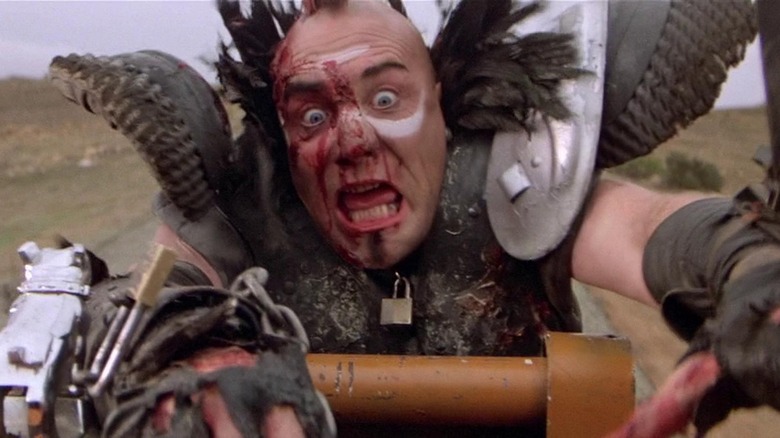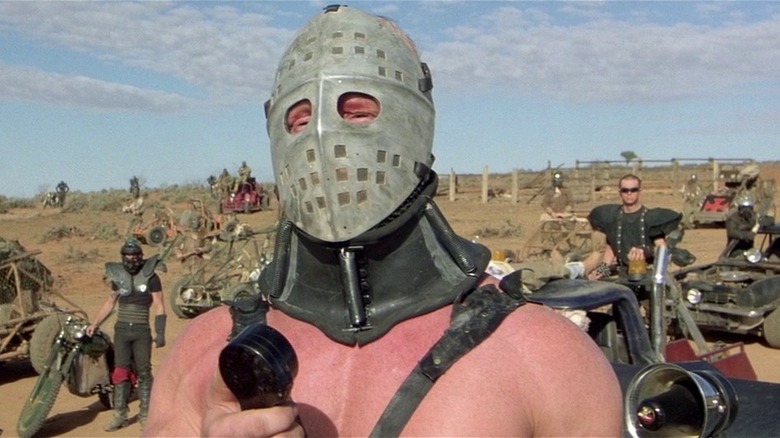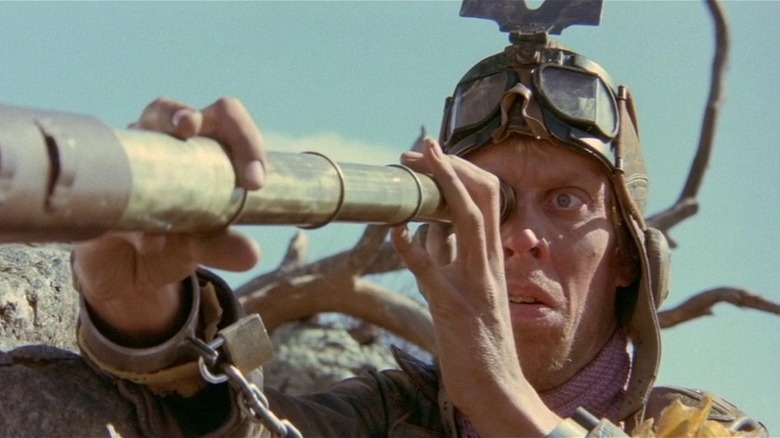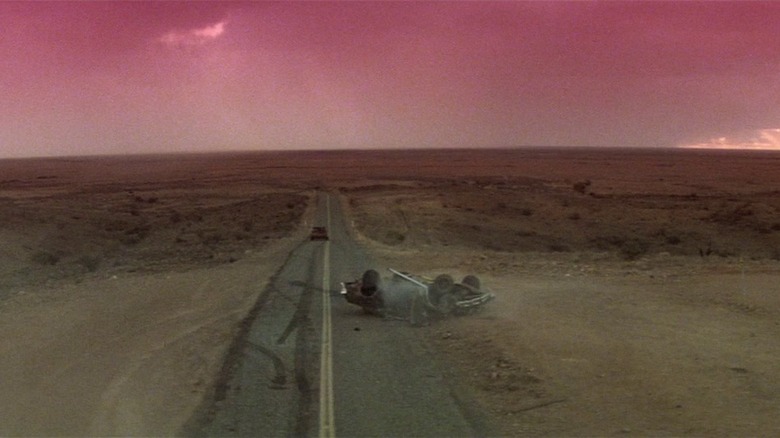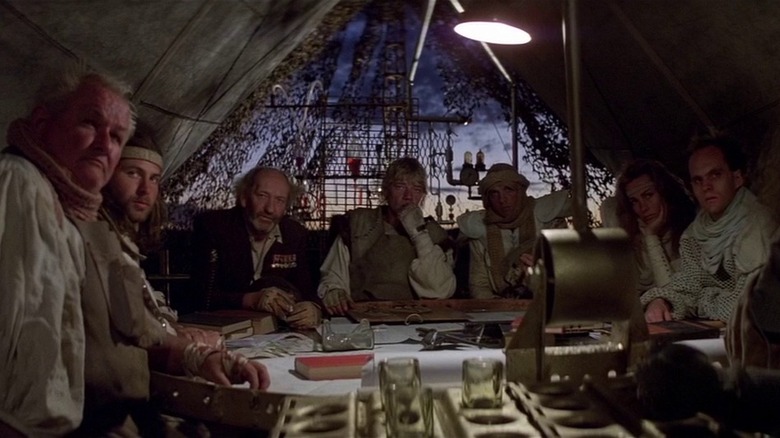Mad Max 2: The Road Warrior's Stunts Were More Dangerous Than You Think
I never loved cars, but I did take them for granted. At college in Ohio, cars represented the only means other than an irregular shuttle to go anywhere or do anything outside of school. They are essential to the lives of millions of people in the United States and around the world. But they are also dangerous. According to the World Health Organization, roughly 1.3 million people worldwide die in car accidents each year. In the United States alone, a report by the National Safety Council found that cars killed 42,060 people in 2020.
"Mad Max 2: The Road Warrior" ends with a car chase. Our hero Max drives a Mack truck to transport a settlement's full stock of gasoline to safety. He is pursued by a flotilla of cars and motorcycles, scavenged from the dump and fitted with weapons. One of them is the charismatic leader Humungus, who bears a needlessly ornate Smith & Wesson. Another is Wez, a mad man with a mohawk whose loved one was killed by Max's ally the Feral Kid. These eccentric heroes and villains blast through the Australian outback at high speeds. You could not simulate the film's climactic chase with the computer effects available at the time. You needed real people to jump from one car to another, real cars to smash. The most "mad" thing about the "The Road Warrior" is not the fetish gear or the violence. It is that when the Mack truck crashes in the climax, it is being steered by a person.
The make-believe world of the movies
Real people were hurt during the making of "The Road Warrior." An authorized video on the film's production captures the injury of Guy Norris. Filling in for Vernon Wells as "Wez," Norris drove his motorcycle directly into a wrecked car and sent himself flying, as required by the script. Ideally, Norris was to control his descent, landing on safety material in such a way as to avoid serious injury. Unfortunately, Norris flipped over several times in the air and lost control. He broke his leg upon hitting the ground. The scene was kept in the film, but Norris himself was removed from set for the rest of the production. To the cast and crew, Norris's injury was an unfortunate accident, a reminder that every stunt carries a risk no matter how carefully the team prepares in advance. To the narrator of the documentary, it is proof that "nothing is more exciting or dangerous than the make-believe world of the movies."
It would be tempting, then, to assume that the crew of "The Road Warrior" was a team of daredevils who risked their necks each and every day for the fun of it, and that the final product only became more exciting because people could have died on set at any time. Fair enough. There is a sense of danger to real bodies in peril that can only be found today in Tom Cruise films or "Mad Max: Fury Road." But "The Road Warrior" was not a reckless production. In fact, "The Road Warrior" could only have been as good as it was because the cast and crew took safety seriously.
The doctor on set
George Miller, the director of the "Mad Max" films, was a doctor before he made movies. According to Kyle Buchanan's "Blood, Sweat & Chrome," he grew up in Queensland operating on victims of car crashes. He would carry the memory of that violence with him to the set of the first "Mad Max" movie. The film's production was a disaster; at the very beginning of the shoot, two members of the crew broke their legs in a motorcycle accident on the way to work. Miller nearly quit his job as director on the spot. "We haven't even started," he said, "and people are gonna die." Thankfully, he changed his mind. Miller came to realize over the course of production that the challenges that intimidated him were just part of filmmaking. "It wasn't until I spoke to Phil Noyce and Peter Weir, and they said, 'Oh, it's always tough ...' it really changed my attitude." Miller made movies following "Mad Max" with the knowledge that filmmaking could kill as surely as a car.
Crashing the Mack truck in "The Road Warrior" meant planning for every eventuality to protect the life of the driver. According to the website Mad Max Movies, the glass of the windscreen was replaced with steel to protect the driver from broken glass and outside projectiles. The back of the cabin was reinforced by a steel framework to prevent the trailer mounting from penetrating the cabin, should the mounting break from the force of impact. A safety crew followed in a dune buggy, with an ambulance and helicopter at hand to rush the driver to safety if needed. Every one of those layers of safety, even the ones that remained untested, were necessary to avoid injury or death.
Crashing the truck
The driver of the Mack truck in the film was not a stunt driver by trade. According to Luke Buckmaster's book "Miller and Max," Dennis Williams was a truck driver who met members of the "Road Warrior" crew at a car dealership. When the team told him what they planned for the climax of the film, Williams knew that there was no way Max's actor Mel Gibson could successfully crash a complex vehicle like the Mack. They needed somebody with experience driving trucks to do the job. The one member of the team with said experience, Gerry Gauslaa, was busy doing stunts. In the end, Williams himself was hired to crash the truck. Williams was understandably terrified; after all, his job wasn't to crash trucks, but to avoid crashing trucks at all costs. If he botched the stunt and left the truck insufficiently damaged, the film would be in serious trouble.
Williams managed to pull off the stunt successfully. For this we can credit his bravery and personal expertise. We may also credit members of the crew who offered him advice, like the previously mentioned Guy Norris. But most important of all was the culture of "The Road Warrior" production. The crew had more money to work with and were also more experienced than when the first "Mad Max" was produced. They shot scenes quickly and efficiently, but took great care in doing so. Whether a crewmember was a professional like Guy Norris or a relative amateur like Dennis Williams, every measure possible was taken to ensure that they would emerge from the production in one piece. Later George Miller projects like "Fury Road" were much harder on the crew, but were just as concerned with ensuring their physical safety.
An industry of bodies
What this means, of course, is that the folks who brought earlier "Mad Max" films to life would return to the later ones. Fair and responsible treatment breeds loyalty as surely as genius. Dennis Williams was hired once again as a stunt driver for "Mad Max: Beyond Thunderdome." Guy Norris served as supervising stunt coordinator on the set of "Fury Road," and personally crashed the War Rig in the finale. It's tough to imagine "Mad Max," or practical effects in general, having a future in Hollywood without the input of experienced craftspeople like Williams or Norris.
Digital effects today are farmed out to countries without unions willing to work cheap, long hours. In recent projects like "Rust," members of the crew lost their lives due to lax safety precautions. Perhaps it is true that "nothing is more exciting or dangerous than the make-believe world of the movies." But movies are made by people, and those people are certainly not make-believe. We need a film industry that treats bodies with care; we need more doctors.
